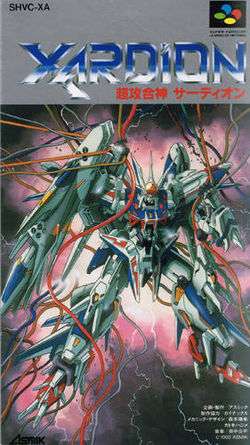Xardion
| Xardion | |
|---|---|
 Japanese cover art | |
| Developer(s) | Jorudan |
| Publisher(s) | Asmik |
| Platform(s) | Super NES |
| Release date(s) | |
| Genre(s) |
Action Side-scroller Platformer |
| Mode(s) | Single-player |
Xardion (超攻合神サーディオン Chou Kou Gasshin Sādion, lit. "Super Attack God Xardion") is an action platformer video game where the player controls robots with different skills in order to defeat the enemy and reach goals.
Story
The inhabitants of the three worlds in the Alpha 1 Solar System have been at war for seven months before hostilities upon the threat of invaders from the artificial world NGC-1611. The Alpha 1 Federation has gathered together the systems best defenses in an effort to repel the invasion. Two mecha (with human pilots) and a self-aware robot are dispatched to NGC-1611, charged with the task of destroying the invader's power source and, if possible, locate the legendary weapon Xardion in the process.
The History of NGC-1611
Planet NGC-1611 is a typical world in all ways, omitting that it was constructed from raw materials by an unnamed scientist. His desire was to create a planet which could not die. His work was dubbed "Project New Frontier." The project was a failure, and violent monsters rapidly evolved, making NGC-1611 uninhabitable by humans. The scientist's final instructions to the supercomputers that once managed the planet were: "Protect my daughter! Eliminate all intruders."
However, the scientist's daughter died after these instructions were given. The supercomputers, not knowing how to proceed with their directive, eventually found a holographic image of the scientist's daughter and projected it into a protective capsule. They chose to defend that capsule in place of the actual girl. Sometime after, an undisclosed event or chain of events lead the supercomputers to send an invasion to the Alpha 1 system.
Characters
Three champions, one from each planet, were sent to NGC-1611. Two pilots operate two transforming mecha, with a space fighter in story scenes and a giant robot in game play. The third is a self-aware A.I. robot that has similar two forms as well. The player picks which one to use each with its own special talents and weapons.
- Triton - Humanoid. Carries a blaster and can fire upward.
- Alcedes - Beast Bot/Mage that resembles a humanoid/insect and has four arms. Carries a staff. Fires a small laser projectile from antenna.
- Panthera - Cat-like. Quadruped robot, can avoid danger more easily, but cannot jump as high as Triton or Alcedes. Is able to get into small spaces that the others cannot. Shoots a blast from shoulder mounted guns.
- Xardion - The ultimate mecha cyborg. Xardion is gained later in the game, and replaces Panthera. Fires blast from arm appendage.
Gameplay
While possessing the typical qualities of action platformers at the time it was made (jump, duck, shoot etc.), Xardion made use of a few novel elements. Additionally, the game had a role-playing element where experience points could be accrued by defeating enemies and bosses, and each level up increased the player's maximum life and special ability points.
During the game, the player takes control of one of three available robot forms. Each form represents one of the three inhabited worlds in the system: Alcedes, from the Desert Planet; Triton, from the Water Planet, and Panthera, from the Jungle Planet.
Each form has its own particular abilities and weaknesses. For example, Panthera is less than half the height of the others, and as such can enter narrow passages to collect items. Additionally, each form possesses its own health and special ability points, and must be upgraded separately from the others. This is equivalent to a 'tag team' game mechanic, where one heavily-damaged character can be swapped instantly for another.
Eventually, one of the robot forms is replaced by Xardion, which combines the abilities of all three previous forms and exceeds them. Xardion only becomes available near the end of the game, but joins the team at level one. An obstruction that can only be cleared by a sufficiently leveled Xardion forces the player to return to earlier levels in order to gain levels and develop special abilities.
Development
Gainax, of Evangelion and FLCL fame are listed in the credits as providing development and planning assistance. Their actual involvement in the game's development is uncertain. The game's main mecha designs were designed by Moriki Yasuhiro, who also worked on designing Zeorymer for the OAV Hades Project Zeorymer and Hajime Katoki, who did major designs of the Mobile Suits from the Gundam franchise.